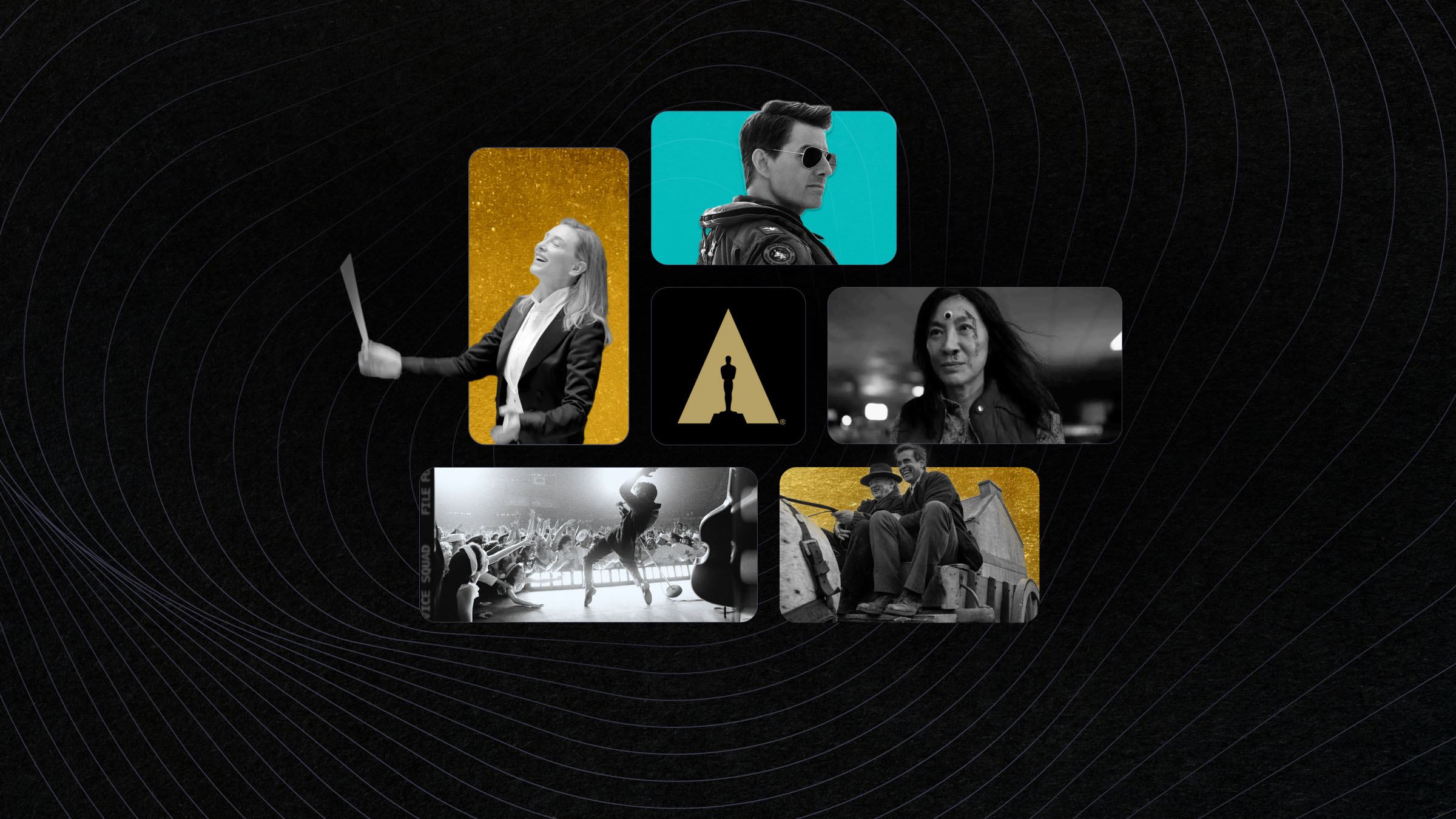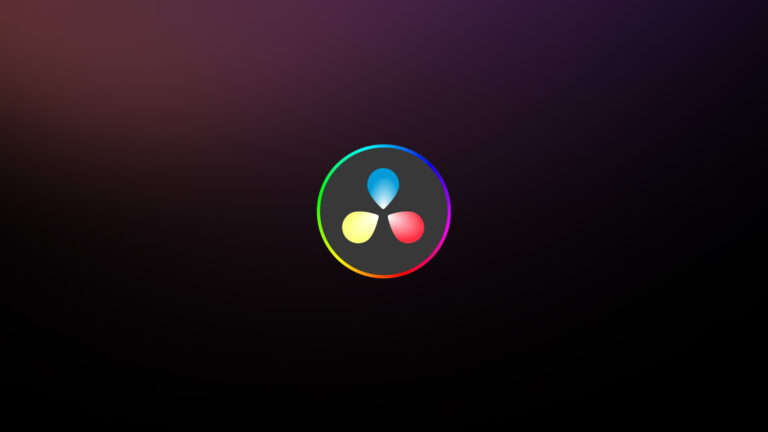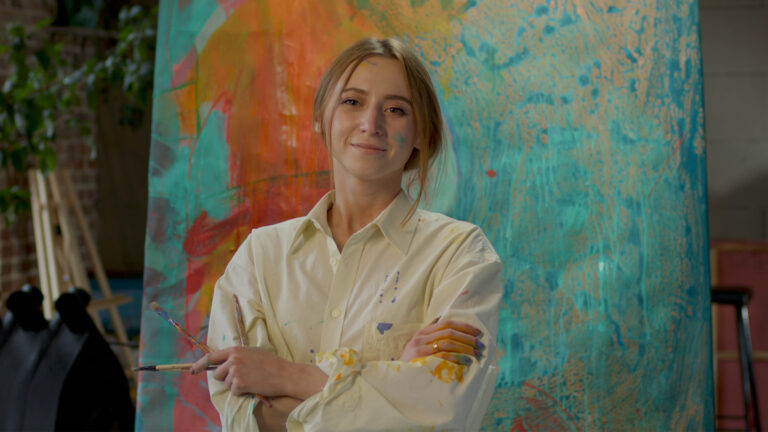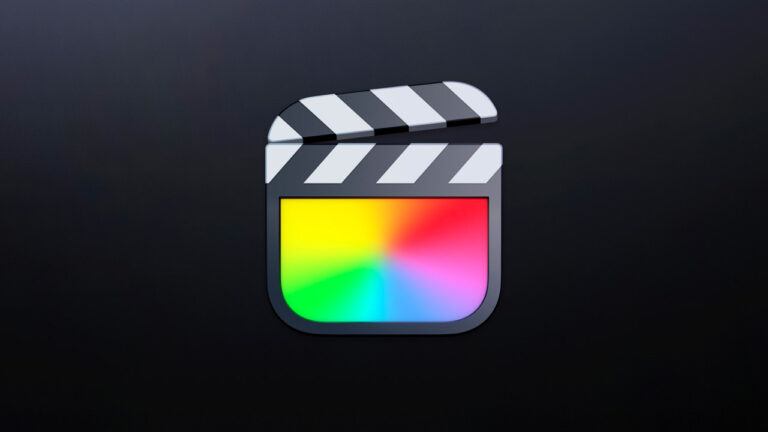If you’d like to know what goes into creating an Oscar-winning movie, then you’ll definitely want to read this year’s epic Oscars workflow guide as it’s packed with post production insights for all of the Best Picture nominees. But if you want to know what it takes to pick up a Best Editing Oscar, you’re in the right place. Kind of.
Rather than picking apart specific scenes from this year’s nominees, we’ll be taking a look at how the Academy Awards work, instead. We’ll see if there are any patterns to be found in the winning films of the past 50 years that help determine success, and maybe put a few common assumptions to rest along the way.
First, let’s start with congratulations to this year’s nominees for the Academy Award for Best Editing:
- Paul Rogers for Everything Everywhere All at Once
- Eddie Hamilton for Top Gun: Maverick
- Monika Willi for TÁR
- Mikkel E.G. Nielson for The Banshees of Inisherin
- Matt Villa and Jonathan Redmond for Elvis
How the Oscars actually work
Now let’s take a look at how the Academy Awards process actually works, as this obviously shapes who the winners are. It begins, of course, with The Academy.
The Academy of Motion Picture Arts and Sciences (AMPAS) has over 10,000 members, although not everyone votes. All of the members with voting rights get to take part in the nomination and winner selection process.
Once a film meets the criteria required for nomination—which includes things like “premiered in a theater,” or “ran for seven days in cinemas in LA county,” etc.)—all of the voting members in a particular category get to submit up to five eligible films for nomination.
So, all the editors get to nominate five films each for Best Editing, all the screenwriters for Best Original Screenplay etc. The exception to this is the Best Picture nomination, where everyone in the Academy can submit between 5-10 films for consideration.
All of these nominations are listed in order of preference, with your top choice in first place, next favorite in second place etc. And that’s when the math kicks in.
Ranked choice voting
The Academy Awards run on a system called “ranked choice voting,” which is explained in this video.
In simple terms, it boils down to this:
- All of the first place votes for each nominated film are added up.
- If the film gains enough first place votes to pass ‘the magic number’ then it becomes a nominee.
- The ‘magic number’ is calculated by “taking the total number of ballots received in a given category and dividing it by the total number of possible nominees plus one.”
For example, if 12 films/editors are nominated for Best Editing and there are 700 voting editors in the branch who all submitted ballots, then the magic number starts at 54.
(700 / 13 (12+1)) = 54 (rounding up)
So the first film/editor to get 54 or more first place votes becomes a nominee.
The nominee with the fewest first-place votes is eliminated and their ballots are then re-distributed based on the second place votes within them, until further nominees surpass ‘the magic number’.
The process is repeated for successive rounds until five nominees remain.
Picking the Oscar winners
Choosing who actually wins is much more straightforward. Once all of the nominees are chosen, everyone in the Academy is sent a complete list of all nominees in each category. Everyone votes on everything, but this time with only one vote per category.
The nominee with the most votes wins.
Again, the exception to this is Best Picture, which runs on the same ranked choice procedure as the nominations.
Industry experts?
So let’s stop for a moment and consider this. Editors get to nominate which five films are considered worthy of an Oscar nomination for Best Editing—based on their insider understanding and experience in film editing—but then everyone in the Academy, from actors to hair stylists, gets to vote on their ‘favorite’ from each category. Including Best Editing.
For this reason, the process is potentially more about the voters’ subjective experience of the film, rather than any observed craft within. Certainly more so than an Eddie, The American Cinema Editors awards, which is voted for purely by editors and post production professionals. And even then, the editors have very different opinions on what makes an edit award-worthy.
But let’s see what the data says!
Oscar winners—50 years of data
Let’s look back through the past winners and see if any clear correlations or patterns emerged in the data. There’s a lot of it, given that we’re closing in on nearly 100 years of Academy Awards (2023 is the 95th Academy Awards) and there are 24 unique award categories. Not to mention the scientific and technical achievement awards, too. (Shout out to the Adobe Substance 3D team for their Scientific and Technical Oscar this year!)
Infinitely honored to receive, w/ Christophe Soum, Nicolas Wirrmann and Sylvain Paris, a "Technical Achievement Award" from the Academy, for Substance Designer. Full circle for me, passionate about VFX and animation for as long as I can remember…https://t.co/JqjRguq7qE
— Sebastien Deguy (@SebDeguy) February 3, 2023
Sourcing a list of winners from the Academy Awards official database, I constrained my investigation to the following four award categories: Best Picture, Best Editing, Best Sound, and Best Directing.
My hypothesis here is that editing is so fundamental to the success of a film (Best Picture), and so entwined with sound, that wins for these categories might also correlate to wins for Best Editing.
The Best Director category, to my mind, is also closely aligned with Best Picture too, so I was curious to see how closely they were connected.
I then tallied up how frequently the following events occurred:
Oscar winners—some correlations
According to the data, in the past 50 years, the movie that took home the Academy Award for Best Picture also won a Best Editing Oscar 19 times. Which is 38 percent of the time.
Looking at how often the Best Picture Oscar-winner also won Best Directing but didn’t win Best Editing and Best Sound and the correlation is much lower—20 times, or 40 percent.
Over the same period, the winner of a Best Editing Oscar took home the award for Best Sound 24 times, or 48 percent. And on just seven occasions, a single movie has been awarded all four—Best Picture, Best Directing, Best Editing, and Best Sound.
But Best Picture and Best Director Oscars have been awarded to the same movie 37 times, or 74 percent of the time.
The results are in
So what does all this tell us?
Well I was wrong, for one thing! Despite the seemingly obvious assumption that you have to win Best Picture to get Best Editing, the correlation between a film winning Best Editing and also winning Best Picture isn’t that strong, as it only happens 38 percent of the time. And you’d need something above 50 percent to say it’s significant.
When it comes to winning both Best Directing and Best Editing, these are won by the same film 40 percent of the time. This is a slightly stronger correlation than the one between Best Editing and Best Picture, but not by a significant amount.
The correlation between a film winning Best Editing and also winning Best Picture isn’t that strong.
Also, it’s only slightly more likely for two different films to win a Best Editing Oscar and Best Sound, than for the same film to win both (52 percent vs. 48 percent). And, at 28 percent, this isn’t often connected to the same film also winning Best Picture that year.
But the strongest correlation is clearly the one between winning Best Picture and Best Directing. That this happens 74 percent of the time is very significant. Obviously if the film is really good, and everyone thinks so, they equate much of that success to the director.
So the numbers indicate that the characteristics that Academy voters look for in a Best Picture have more in common with aspects of the movie like (maybe) the performances, the script, the cinematography, the production design etc. rather than the editing.
This is actually encouraging news
The fact that, by and large, there isn’t a really strong correlation between the categories is hopefully encouraging news.
Why? Because each category’s winners are largely awarded independently of the other categories, with the exception of Best Director and Best Picture.
In fact, you’re slightly more likely to win Best Editing if your director also wins Best Directing (40 percent vs 38 percent) but winning Best Editing doesn’t lay the groundwork for also winning Best Picture (38 percent).
That said, with only 50 years in my data set, it’s possible that the information is just too constrained to draw any statistically significant, or at least practically indicative, conclusions from. But it was fun, regardless.
Interesting Oscars-related facts
As a quick aside, the two editors with the most Oscar nominations and awards are Michael Kahn and Thelma Schoonmaker. They’ve picked up an impressive eight nominations and three awards each. Worthy runners-up are Daniel Mandell and Ralph Dawson who have three Best Editing Oscars each.
Sadly, Gerry Hambling and Frederic Knudston, have both garnered six nominations each. But no wins. Always a bridesmaid…
Who might win in 2023?
Based on what we now know about how the voting systems work (and what I personally think) there are two ways to pick up an Oscar for Best Editing. The first is to be part of a really good film that everyone feels is generally ‘worthy’ of such an award. The second is to demonstrate such extraordinary editing ability that everyone feels that it should win for such an achievement.
So if we apply that logic to this years’ nominees which, by inclusion, can all be considered “very good films” it’s fair to conclude that the creative and technical abilities displayed in the editing of films like Everything Everywhere All at Once or Top Gun: Maverick are more obvious—and therefore more likely candidates for the win. While the more subtle scene building of Tár or The Banshees of Inisherin is less likely to grab the attention of the non-editors who make up the majority of the voting pool.
About time?
One thing that’s interesting about this year’s nominees is that only one of them has ever been nominated before—Mikkel E.G. Nielson, who won Best Editing in 2021 for The Sound of Metal. So there’s no sense of “Well I can’t believe they didn’t win for X, they really need to win this time.”
One example of this would be Martin Scorsese winning Best Director for The Departed, over The Aviator, Gangs of New York, Goodfellas, The Last Temptation of Christ or Raging Bull. All movies for which he was previously nominated for Best Director, but never won. (Much like Leonardo DiCaprio, who finally picked up Best Actor after five nominations—including Scorsese’s The Aviator.)

Does this mean that Mikkel E.G. Nielson is less likely to win for Banshees? If your assumption is that voters might subconsciously think “He won last year, so maybe it’s better to give it to someone else this time,” then maybe. We won’t have to wait long to find out.
Only twice before has the same editor won in consecutive years, with Ralph Dawson; A Midsummer Night’s Dream (1935) and Anthony Adverse (1936) and Kirk Baxter and Angus Wall winning for The Social Network (2010) and The Girl with the Dragon Tattoo (2011).
Or it might be that Academy members will vote for a film to win a branch category, subconsciously trying to balance their vote for a different movie in the Best Picture category. It’s possible. Based on the numbers, you could argue that it’s happened 62 percent of the time in the past 50 years.
BAFTA predicts?
Another assumption is that the BAFTAs seem to correlate with the Oscars quite tightly, both in terms of nominations and winners. And this certainly stands up to closer scrutiny this year, with just one difference in the nominations between the BAFTAs and the Oscars—All Quiet on the Western Front instead of Tár.
But when it comes to predicting the Best Editing Oscar, the BAFTA pick for Best Editing has only matched the subsequent Oscar-winner 32 percent of the time. So it’s not that predictable.
What’s not clear is how much overlap there might be between the memberships of BAFTA and The Academy, and whether this might also be a factor. But it seems more likely that judges are all looking for similar things when they cast their votes, and it makes sense that they agree for the most part.
My prediction?
I’m flattered that you asked. As I’m neither a member of BAFTA nor the Academy, my opinion literally doesn’t count. But I’m torn about my pick for the winner for Best Editing Oscar this year.
My call is that it’ll either be Everything Everywhere All at Once or Top Gun: Maverick. Two completely different movies, but with abundant displays of sheer editorial creativity.
And I have a 40 percent chance of being right.
Footnote—the Best Sound category
As a quick aside it worth noting that the category for ‘Best Sound’ is a moving target, which at various times has consisted of:
- Best Sound Mixing (1929/30 – 2019)
- Best Sound Editing (1963 – 2019)
- Best Sound Effects Editing (1963 – 1999)
- 2003-2019 Best Sound Mixing and Best Sound Editing
- 1982-2003 Best Sound and Best Sound Effects Editing
- Best Sound Recording 1929-1957
So I used the winner of Best Sound Editing for the ‘Best Sound’ category in my data set to keep things simple.
As of 2020 there is now one ‘Best Sound’ category with The Sound of Metal winning in 2021 and Dune winning in 2022.




